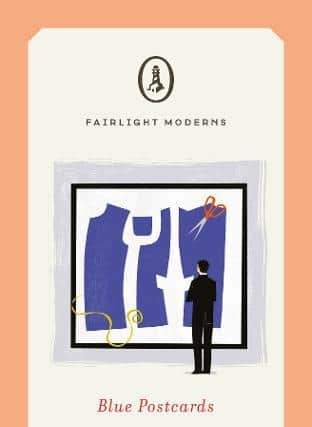Book review: Blue Postcards, by Douglas Bruton


There are some novels that are more like conceptual art works than standard narratives. This is no bad thing, and I would certainly not want us to be stuck with three-volume Victorian works, much though I love three-volume Victorian works. The clue’s in the name: the novel ought to be novel. If it doesn’t stretch what being a novel means, then it is merely a form of unknowing plagiarism. So it was rather a delight to read Blue Postcards. It is an ingenious book, and I think it will linger with me for quite some time.
The novel has an intriguing schematic. It is divided into five sections of 100 chapters each, in imitation of the postcards which play a prominent role in the narrative. It is braided through three different stories. We have Henri, a tailor on the Street of Tailors in 1950s Paris. As you might imagine he is Jewish and has a backstory. In the almost present day, an unnamed elderly man buys a postcard, entirely blue with a blue stamp and a significant date from a woman called Michelle at the base of the Eiffel Tower. They start to form a relationship – or do they? He is a reliably unreliable narrator. Interspersed are stories about the artist Yves Klein, famous for his monochrome blue paintings in the paint he patented, International Klein Blue. Klein turns up at Henri’s shop, and as well as having blue chalk dust on his fingers, he has a superstition of weaving a Tekhelet thread, a kind of charm, into each of the suits he makes, but secretly.
Advertisement
Hide AdI am sure you can see where this is going. As well as historical fiction, literary melancholia and art history there is a theme that runs through: the colour blue. Each and every “postcard” will use the word blue, in terms of everything from Klein’s painting to the colour of a gas flame, to Willow Pattern porcelain, to the eyes of a father or a beloved, to the colour of the night sky in Van Gogh, to a tattoo on a wrist or the traditional colour of the Virgin’s dress. The anonymous narrator begins the story with a story about a man, with a piece of lapis lazuli in a tooth, who did the three cup trick. This novel, in many ways, is a kind of three cup trick. The ball, or marble, or nut is never where you think it is going to be.


Klein is an extremely interesting artist, best known for his blue paintings. But there was more to him than that. In some ways he made performance art and installation art mainstream. His gallery opening that featured nothing but a whitewashed room is one example; his stunt of offering identical paintings at variant prices; his “leaps” where he seems to be suspended over average Parisian streets are all astonishing. I first saw his work at the Pompidou in Paris, and was bemused and intrigued. They glowed. They were unmoveable. Even the ones where he had naked women lie, covered in his trademark paint, on a canvas were moving. (A human had been there). Klein’s work may recall the prankster antics of Marcel Duchamp or the sly challenges of Joseph Beuys, but in the end he is much closer to Kandinsky. He wanted to see colour, but see it purely.
The other narratives makes a balletic form around the discussion of Klein. The reader is warned early on that the anonymous narrator’s flirty friend “is a memory. The one that got away, for we all have those stories, except a writer can rewrite his story and maybe this time she does not get away but stays on the page, fixed in blue ink.” As the narrator wryly says “I know that if you are reading this it will be printed in black ink.” The character of Henri is an enigma; silent mostly, reserved the whole time, with more than one secret he is assiduously repressing. There is something loveable about this quiet man, making odd rituals, in a road that no longer exists. So despite its art history background, the novel has an emotional truth and a sensitivity.
In one aside, the narrator mentions the Italian author Dino Buzzati, and his article “Blu, Blu, Blu”. With a degree of sardonic humour he continues “With its talks of madmen and revolutionaries and the fanatics of the extreme avant-garde, it brought people to the exhibition in great numbers.” Satirical, yes, but threaded with a kind of plangent hope for the days when art was turning the world upside down.
The trio are all dubious. They lie, they misremember, they obfuscate. But that blue thread links them and in a way it is surprising that the most famous other meaning – the blues – is not mentioned. They are all, successful or not, having a blue time of it. Other writers have written about the ambiguous nature of blue – the Virgin, the movies, the sky, the sea – including Michel Pastoreau, Carol Mavor and Rebecca Solnit in her Field Guide to Getting Lost. This book will go on my blue shelf, and I will re-read it, because as well as being clever it is kind.
Blue Postcards, by Douglas Bruton, Fairlight Books, £7.99
A message from the Editor
Thank you for reading this article. We're more reliant on your support than ever as the shift in consumer habits brought about by coronavirus impacts our advertisers.
If you haven't already, please consider supporting our trusted, fact-checked journalism by taking out a digital subscription at https://www.scotsman.com/subscriptions